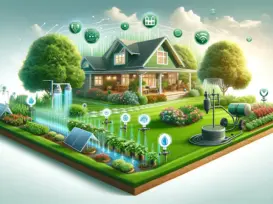Grus Home Energy - soil moisture sensors
Maximizing Crop Yield with Advanced Soil Moisture Sensors: Ensuring Optimal Irrigation
Maximizing Crop Yield with Advanced Soil Moisture Sensors: Ensuring Optimal Irrigation
Soil moisture sensors are a pivotal tool in the arsenal of modern agriculture, where precision farming has become increasingly important. These devices are designed to accurately measure the moisture levels within the soil, providing essential data that can help farmers and gardeners make informed decisions about watering their crops. The primary goal of utilizing soil moisture sensors is to optimize irrigation practices, conserve water, and increase crop yield, while preserving the health of the soil ecosystem.
Soil moisture is a critical parameter for plant health as it directly affects the availability of nutrients and the aeration of the soil. Too much water can lead to root rot and fungal infections, while too little can stress plants, impede growth, and eventually lead to crop failure. Soil moisture sensors help to avoid these issues by ensuring that plants receive the right amount of water at the right time.
There are various types of soil moisture sensors available in the market, including tensiometers, gypsum blocks, capacitance sensors, and time domain reflectometry (TDR) sensors. Each type operates on different principles and offers varying degrees of accuracy and cost. Tensiometers measure the tension of water within the soil, which correlates with moisture content. Gypsum blocks change resistance in response to soil moisture. Capacitance sensors utilize the soil’s dielectric constant to infer moisture content, and TDR sensors use the speed of an electromagnetic pulse through the soil.
One of the greatest advantages of soil moisture sensors is their ability to provide real-time data. This enables the automation of irrigation systems, where watering can be precisely controlled and adjusted based on the moisture levels detected, saving time and reducing labor costs. This is especially beneficial in regions where water resources are scarce or during periods of drought. By delivering water only when and where it is needed, farmers can significantly reduce water waste.
Additionally, soil moisture sensors can help in identifying the variability of soil moisture across different parts of a field. This variability can be due to differences in soil texture, compaction, organic matter content, or topography. By mapping this variability, farmers can practice variable rate irrigation (VRI), where different parts of a field are watered according to their specific needs. This not only conserves water but also prevents over-irrigation, which can leach nutrients away from the root zone, causing pollution and additional expenses in fertilizer application.
Integrating soil moisture sensors with other technologies such as weather stations, satellite imaging, and crop models can further enhance decision-making. For instance, by combining soil moisture data with weather forecasts, farmers can plan irrigation schedules more effectively, reducing the reliance on guesswork and historical averages.
The environmental benefits of using soil moisture sensors should not be overlooked. Improved irrigation efficiency leads to less runoff and reduced erosion, protecting local waterways from sediment and nutrient pollution. It also contributes to the conservation of groundwater resources and helps maintain the natural balance of local ecosystems.
In conclusion, soil moisture sensors play a vital role in sustainable agriculture. They provide the data needed to water crops efficiently, ensuring that plants get the moisture they need without wastage. The integration of these sensors into modern irrigation systems serves as a win-win for both farmers and the environment, improving crop yield and quality while conserving precious water resources.
©2025 All Rights Reserved. Grus IoT Co.,Ltd.
